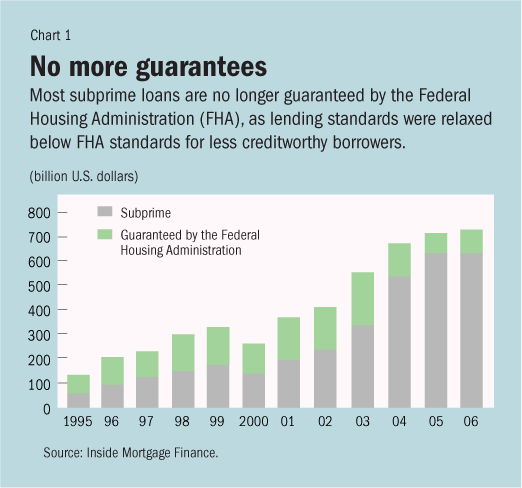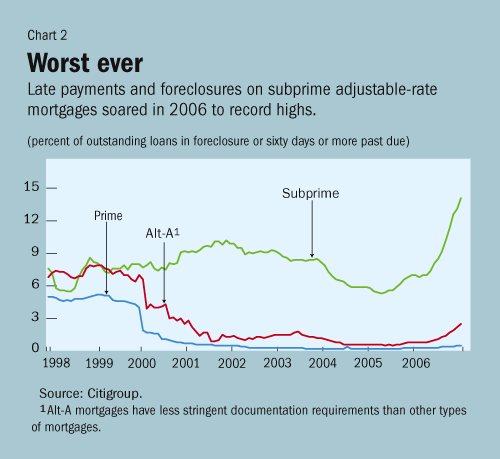
Typical street scene in Santa Ana, El Salvador. (Photo: iStock)
IMF Survey: Lessons from Subprime Turbulence
August 23, 2007
The recent wave of turbulence in credit markets has now directly affected hedge funds, investment funds, and the commercial paper market.

Home for sale in Chicago, United States: tighter regulation of U.S. mortgage transactions appears warranted (photo: Jeff Haynes/AFP)
U.S. SUBPRIME MORTGAGE MARKET
It has prompted collective rescue operations in Germany and Canada and intervention to supply greater money market liquidity by the world's major central banks. The initial trigger was problems in the U.S. subprime mortgage market.
A new IMF working paper traces the origins of the subprime market and its current problems, and reviews the policy options.
Key points
Background: Subprime mortgage lending was facilitated by the introduction of automated underwriting during the 1990s. Securitization (the repackaging of loans) further encouraged market growth by dispersing risk.
The issue: New loan origination and funding technology has protected lenders from significant losses but has made them more dependent on capital market liquidity. In the process, consumer protection has been undermined.
Policy implications: Regulators should tighten oversight while preserving the viability of the securitization model.
The new loan origination and funding technology employed in the subprime area has protected depositary institutions from significant losses at the risk of greater dependence on capital market liquidity and the expense of undermining consumer protection.
What is subprime lending?
Subprime mortgages are residential loans that do not conform to the criteria for "prime" mortgages, and so have a lower expected probability of full repayment. This assessment is usually made according to the borrower's credit record and score, debt service-to-income (DTI) ratio and, in some cases, the mortgage loan-to-value (LTV) ratio.
Several legal milestones during the 1980s, coupled with the introduction of automated underwriting during the 1990s, encouraged the growth of the market (see Chart 1). Securitization also facilitated market growth by dispersing risk, providing investors with a supply of highly-rated securities with enhanced yield, and opening up the mortgage origination business to specialty finance companies.

These developments allowed a relaxation of credit rationing for marginal borrowers previously considered too risky by traditional lenders, resulting in a substantial expansion of the U.S. homeownership rate since the mid-1990s.
Closing affordability gap
Recent subprime lending growth was boosted by more highly leveraged lending against rapidly rising house prices. However, by 2005-06 higher DTI and LTV ratios were insufficient to close the housing affordability gap for many subprime borrowers, so lenders started to offer "affordability" products. These included "hybrid" and "option" adjustable-rate mortgages (ARMs) that require payments at low initial fixed "teaser" rates—which can result in negative amortization during the first few years.
As long as house prices were rising, the rate reset shocks that occurred when the teaser rates expired could be averted by refinancing the mortgage into another hybrid or option ARM. But many lenders and borrowers knew, or should have known, that such loans were not viable at the full interest rate.
The combination of fee-driven remuneration at each stage of the securitization process and the dispersion of credit risk weakened prudent lending incentives. For example, it became common to reduce or eliminate income verification requirements—so-called "low- and no-doc" loans. By the end of 2006, subprime mortgages comprised about 15 percent ($1.5 trillion) of outstanding mortgages, of which $600 billion were originated in 2006. Of these, about 90 percent were ARMs, most of which incorporated affordability features.
Rise and fall of subprime lending
As house price appreciation decelerated in 2006, delinquencies and defaults on subprime mortgages originated in 2006 soared, despite a benign economic backdrop (see Chart 2). While prices were rising, distressed borrowers had the equity to renegotiate their loans or could sell their homes and prepay their mortgages.

However, slowing house price appreciation and rising interest rates left many stretched borrowers with no choice but to default. The highest delinquency rates have been associated with hybrid and option ARMs, particularly those that involved risk "layering"—high LTV loans to high DTI borrowers with little income verification.
The speed with which delinquency and default rates have risen for the 2006 vintage of loans has been striking. The first sign of trouble was the high volume of "early payment defaults," (EPDs) in which the borrower misses one or two of the first three monthly payments, which has been followed by rising delinquency rates. Fraud also appears to have played a key role in accelerating the deterioration, which resulted in the failure of a number of originators in 2006-07 as securitizers exercised "put-back" options—forcing lenders to take back delinquent mortgages.
Sizing up losses
The rapid rise in EPDs and delinquencies initially affected the thinly-capitalized specialist mortgage lenders (representing about 40 percent of 2006 subprime originations), who have either closed operations, declared bankruptcy, or been bought out. Commercial and investment banks have declared losses from holding subprime mortgages outright or residual interests in securitization transactions they have arranged, but these have been limited thus far.
However, losses have primarily appeared among the holders of securitization products (mortgage-backed securities and collateralized debt obligations) with particular exposure to 2006 subprime and Alt-A mortgages (mortgages relying on limited documentation). The size of these losses will depend on the dollar volume of defaults among the underlying mortgage loans and on the timing of loss realizations. Almost all of the losses will be absorbed by collateralized debt obligations, with mark-to-market loss estimates ranging from $100 to 200 billion. By comparison, the Savings and Loans crisis of the early 1990s resulted in total losses of approximately $150 billion—much larger as a share of U.S. banking sector assets.
Losses have crystallized in hedge funds specializing in lower-rated subprime mortgage-backed securities, as investor withdrawals and margin calls have forced them to sell holdings in falling and illiquid markets. Also, some other funds and investors with exposures have announced losses and restricted redemptions, prompting wider concerns over counterparty and liquidity risk—especially in asset-backed commercial paper markets.
Lessons learned
Investors have placed excessive trust in rating agencies' approach to structured credit. The ratings methodology for corporate credit risk is fundamentally different from that used for structured credit and yet the ratings that result are placed on the same scale, implying similar potential losses. To avoid future confusion, ratings for the different types of obligation should be clearly distinguished and investors should never just rely on ratings to determine investment policy.
Looking ahead, the combination of interest rate resets will create significant payment shocks for borrowers in 2007-09. In the recent past, subprime borrowers were able to limit payment resets by refinancing. However, with lending standards tightening and house equity falling, this will now be significantly harder. Hence, imminent payment resets mean that defaults on riskier U.S. mortgages are likely to continue rising in the short- to medium term.
So what can policymakers do to avoid a similar crisis in the future?
Improve consumer protection. With lending standards tightening, the appropriate policy response needs to balance improving consumer protection with maintaining the viability of the securitization model that has successfully dispersed credit risk away from systemically important financial institutions. This is a challenging task within a regulatory and legal framework ill-suited to provide effective consumer protection against predatory lending in an originate-to-securitize financial model. Securitizers have access to relevant information over loan quality and one option could be could be to assign (capped) liability to them if checks against fraud and predatory lending in the pools of loans securitized are inadequate.
"Losses should be dispersed to exposed investors rather than taken over by taxpayers if borrowers cannot be assisted through loan modifications"
Tighten oversight. Federal banking regulators have recently tightened guidance on nontraditional and hybrid ARM mortgage lending. However, the fragmented nature of U.S. financial regulation means that observance and enforcement of such standards is not uniform. The five regulators can enforce compliance by their regulated institutions but, since non-bank lenders and loan brokers are regulated at the state level, such initiatives also rely on consistent state-level enactment and enforcement. The U.S. Federal Reserve is reviewing its powers to regulate mortgage transactions and tighter restrictions, especially concerning the clarity of disclosures to borrowers and the availability of the riskiest loans, appear warranted.
Resist pressure for bailouts. Policymakers will face continuing pressure to bail-out or subsidize stretched subprime borrowers. However, such pressures generally should be resisted due to the danger of reinforcing speculative or fraudulent behavior—losses should be dispersed to exposed investors rather than taken over by taxpayers if borrowers cannot be assisted through loan modifications.
This article is based on IMF Working Paper (WP/07/188): Money for Nothing and Checks for Free: Recent Developments in U.S. Subprime Mortgage Markets, by John Kiff and Paul Mills.







